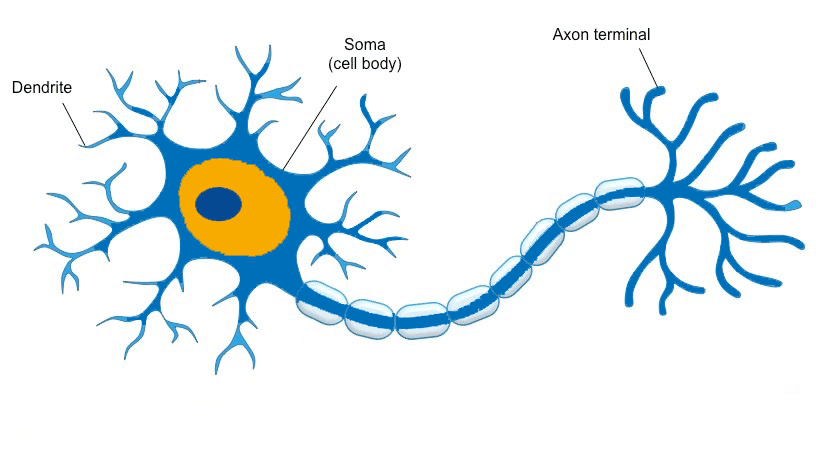The brain is a complex and dynamic 3-pound organ. According to Yale University’s Colón-Ramos lab, “The human brain consists of 100 billion neurons and over 100 trillion synaptic connections. There are more neurons in a single human brain than stars in the milky way!” (2021, para. 1).
A neuron includes a cell body, dendrites, and an axon (see Figure 1). The cell body takes care of the neuron’s basic cellular functioning. Dendrites are tree-like branches that receive signals from other neurons. The axon carries nerve impulses to other neurons. “Neurons communicate through synapses - contact points between the axon terminals on one side and dendrites or cell bodies on the other” (Queensland Brain Institute, 2021, para. 4). These nerve impulses are sent along the axon toward the axon terminals. Myelin sheath wraps around and insulates the axon, which speeds up impulse propagation (communication). Each neuron forms connections (synapses) with up to thousands of other neurons (nerve cells).
“Memories are formed by neurons that fire in our brains, creating or changing networks of connections”(Ikeda & Teasdale, 2019, para. 1). To form memories, The Harvard Gazette states that “the brain must wire an experience into neurons so that when these neurons are reactivated, the initial experience can be recalled” (Jiang, 2020, para. 10). As shared by McTighe and Willis (2019):
Every class, assignment, and experience reshapes each student’s brain through neuroplasticity. Understanding how the brain processes information and changes in response to experiences provides keys to best strategies and interventions for guiding learners to sound understanding and durable, transferrable, long-term memory. (p. 20)
Deliberate practice through well-designed and substantive activities supports learning and the transfer of knowledge and skills across contexts. Dr. Shauna Shapiro, a clinical psychologist and professor of psychology, states “What you practice grows stronger." According to Dr. Norman Doidge, who is a psychiatrist, psychoanalyst, researcher, “You can sculpt your brain by the choices you make” (Doidge, 2017). Hence, understanding neuroplasticity and how the brain learns is critical to instructional design and teaching.
Figure 1
Neuron

Image: Adatis
Learning is far from prior analogies of “the mind is a vessel to be filled” or “the brain is a bucket to fill with knowledge.” According to Dr. Kenneth Wesson (2020), “When the brain learns, new dendrites grow”(para. 2). Therefore, educators are in incredible roles as brain changers. From course design to teaching, educators have the opportunity to design courses that engage students in learning experiences that support the human learning process. “Understanding how the brain converts information into learning provides keys to the best instructional strategies and learning experiences” (McTighe & Willis, 2019). The more educators know about the brain and learning, the greater the opportunities to design courses that optimize learning and support neuroplasticity.
Author: Dr. Kristen Betts
Learn more about how INTERACT123 can support your work with supporting student success through practices that align the human learning process.
